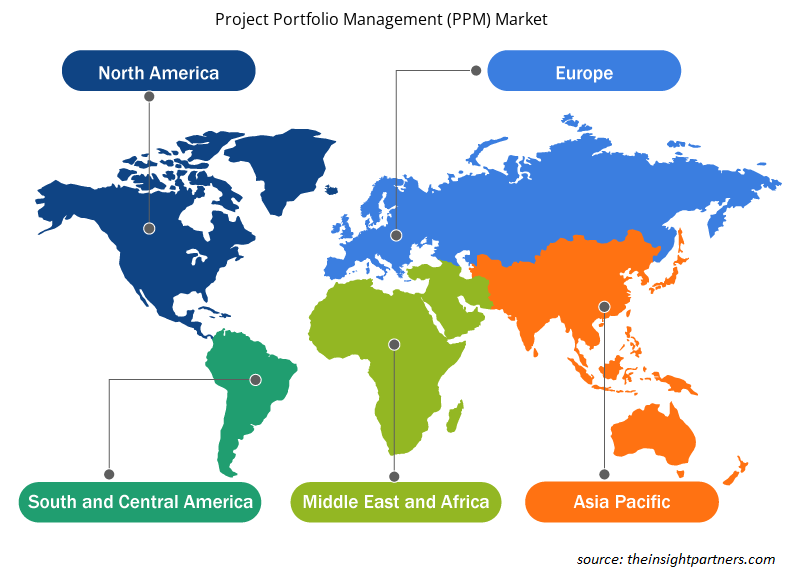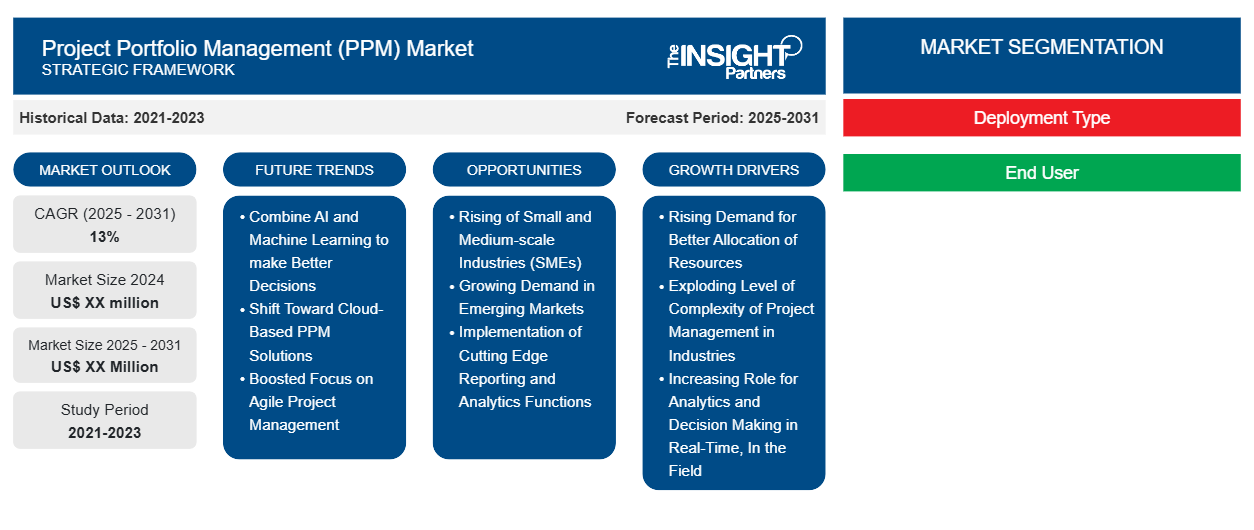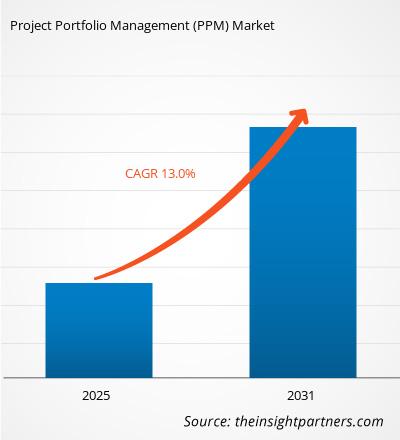Der Markt für Projektportfoliomanagement (PPM) wird voraussichtlich von 2024 bis 2031 eine durchschnittliche jährliche Wachstumsrate (CAGR) von 13 % verzeichnen, wobei die Marktgröße von XX Millionen US-Dollar im Jahr 2024 auf XX Millionen US-Dollar im Jahr 2031 wachsen wird.CAGR of 13% from 2024 to 2031, with a market size expanding from US$ XX million in 2024 to US$ XX Million by 2031.
Der PPM-Marktbericht segmentiert den Projektportfoliomanagement-Markt (PPM) basierend auf Lösungstyp, Bereitstellungsmodus, Organisationsgröße und Branche. Er bietet ein vollständiges regionales Bild der Märkte und Länder für eine globale Ansicht. Marktpreisschätzungen pro Region werden in US-Dollar (US$) angegeben, CAGR-Schätzungen zeigen die Marktentwicklung. Dieser Bericht bietet eine ganzheitliche Analyse der Marktbedingungen, Wachstumstrends und des Marktwettbewerbs nach Regionen und Segmenten.CAGR estimates to display the market development. This report offers a holistic analysis of market conditions, growth trends, and market competition by regions and segments.
Zweck des Berichts
Der Bericht „Projektportfoliomanagement (PPM)-Markt“ von The Insight Partners zielt darauf ab, die aktuelle Landschaft und das zukünftige Wachstum sowie die wichtigsten treibenden Faktoren, Herausforderungen und Chancen zu beschreiben. Dies wird verschiedenen Geschäftspartnern Einblicke geben, wie zum Beispiel:
- Technologieanbieter/-hersteller: Um die sich entwickelnde Marktdynamik zu verstehen und die potenziellen Wachstumschancen zu kennen, damit sie fundierte strategische Entscheidungen treffen können.
- Investoren: Durchführung einer umfassenden Trendanalyse hinsichtlich der Marktwachstumsrate, der finanziellen Marktprognosen und der Chancen entlang der Wertschöpfungskette.
- Regulierungsbehörden: Zur Regulierung von Richtlinien und Überwachungsaktivitäten auf dem Markt mit dem Ziel, Missbrauch zu minimieren, das Vertrauen der Anleger zu bewahren und die Integrität und Stabilität des Marktes aufrechtzuerhalten.
Marktsegmentierung für Projektportfoliomanagement (PPM)
Bereitstellungstyp
Endbenutzer
Passen Sie diesen Bericht Ihren Anforderungen an
Sie erhalten kostenlos individuelle Anpassungen an jedem Bericht, einschließlich Teilen dieses Berichts oder einer Analyse auf Länderebene, eines Excel-Datenpakets sowie tolle Angebote und Rabatte für Start-ups und Universitäten.
- Holen Sie sich die wichtigsten Markttrends aus diesem Bericht.Dieses KOSTENLOSE Beispiel umfasst eine Datenanalyse von Markttrends bis hin zu Schätzungen und Prognosen.
Wachstumstreiber auf dem Markt für Projektportfoliomanagement (PPM)
- Steigende Nachfrage nach besserer Ressourcenzuweisung: Unternehmen setzen auch auf Projektportfoliomanagement-Lösungen (PPM), um die Ressourcennutzung bei verschiedenen Projekten zu optimieren. PPM-Lösungen bieten auch Einblicke in verfügbare Ressourcen und Projektanforderungen, sodass Sie Fähigkeiten und Ressourcen effizient zuweisen können. Mehr als 65 % der Unternehmen geben an, dass sie mehr aus Projekten herausholen, indem sie ihre Ressourcen mit der PPM-Lösung besser verwalten. Dies ist auch einer der Gründe für das starke Marktwachstum.
- Explodierender Komplexitätsgrad des Projektmanagements in verschiedenen Branchen: Da das Projektmanagement durch gleichzeitige, verteilte Projekte und geografisch verteilte Teams immer komplizierter geworden ist, haben PPM-Tools an Bedeutung gewonnen. PPM-Lösungen automatisieren Arbeitsabläufe und verbessern die Teamarbeit – beides ist in Unternehmen wichtig. Mehr als 70 % der Unternehmen mit mehreren Projekten gleichzeitig halten PPM für unverzichtbar, was zu einer Zunahme der Marktgröße und -akzeptanz führt.
- Zunehmende Bedeutung von Analysen und Entscheidungsfindung in Echtzeit im Außendienst: Analysen in PPM-Produkten, die Projektmanagern Echtzeitdaten liefern, damit sie in Echtzeit fundierte Entscheidungen treffen können. Da PPM-Software Entscheidungen in Echtzeit ermöglicht, kommt es zu weniger Verzögerungen und mehr Projekte werden abgeschlossen. Mehr als 50 % der Unternehmen, die Echtzeitdaten verwenden, erzielen auch eine schnellere Projektabwicklung – das ist die Macht der Analysen bei der Steigerung des PPM-Marktanteils.Field:Analytics in PPM products, which provide real-time data to project managers so that they can make informed decisions in real time. Because PPM software allows you to make decisions in real time, projects are less delayed and are more completed. More than 50% of companies using real-time data also see faster project delivery - this is the power of analytics in propelling PPM market share.
Zukünftige Trends auf dem Markt für Projektportfoliomanagement (PPM)
- Kombinieren Sie KI und maschinelles Lernen, um bessere Entscheidungen zu treffen:
Auch die Anwendungsfälle von KI/ML in PPM-Systemen nehmen zu. Diese Tools ermöglichen die Verarbeitung von Daten und liefern Vorhersagen, auf deren Grundlage Entscheidungen getroffen und Risikomanagement betrieben werden kann. Bis 2026 werden fast 40 % der PPM-Lösungen KI/ML-Funktionen enthalten, die eine große Rolle beim Wachstum des Marktes spielen werden, da Unternehmen nach besseren Projektergebnissen streben. - Umstellung auf Cloud-basierte PPM-Lösungen: PPM in der Cloud ist eine fortschrittliche Option, da es flexibler, skalierbarer und zugänglicher ist. Diese Lösungen ermöglichen es Teams, von überall aus in Echtzeit zusammenzuarbeiten – perfekt für multinationale Unternehmen. Mehr als 60 % der Unternehmen planen, ihre PPM-Anwendungen in den nächsten 5 Jahren in die Cloud auszulagern. Umfragen zufolge findet ein radikaler Marktwechsel statt.
- Verstärkter Fokus auf agiles Projektmanagement: Agiles Projektmanagement ist mittlerweile in vielen Branchen beliebt und auch PPM-Systeme passen sich an agile Ansätze an. Das Muster ist auch eine Reaktion auf beschleunigte Projektzeiten und iterative Planung. Agile-kompatible PPM-Tools werden voraussichtlich bis 2025 einen großen Marktanteil halten, da fast die Hälfte der Unternehmen agile Praktiken nutzen möchte, um flexibler und reaktionsschneller auf Projektänderungen reagieren zu können.
Marktchancen für Projektportfoliomanagement (PPM)
- Aufstieg kleiner und mittlerer Unternehmen (KMU): Kleine Unternehmen nutzen PPM-Tools mehr denn je, um Projekte effizienter zu gestalten und mit größeren Unternehmen zu konkurrieren. Mit den in Sichtweite befindlichen kostengünstigen und flexiblen KMU-Lösungen gibt es hier viel Raum für Wachstum. Heute geben fast 45 % der KMU an, dass sie ein besseres Projektmanagement wünschen, und dies wird den PPM-Markt in kleineren Unternehmen wachsen lassen.
- Wachsende Nachfrage in Schwellenmärkten: In sich schnell digitalisierenden Märkten wie dem Asien-Pazifik-Raum und Lateinamerika steigt auch die Nachfrage nach PPM-Lösungen. Da die Industrie- und IT-Branchen dieser Regionen wachsen, steigt auch die Nachfrage nach effektiven Projektmanagement-Tools. Viele Menschen in Indien und Brasilien werden ihre PPM-Nutzung steigern, da ihre projektbasierten Unternehmen im kommenden Jahrzehnt um mehr als 20 % wachsen.
- Implementierung modernster Berichts- und Analysefunktionen: Da Unternehmen sich heute zunehmend auf datengesteuerte Entscheidungen verlassen, suchen sie nach ausgefeilteren Berichts- und Visualisierungsfunktionen in PPM-Lösungen. Je leistungsfähiger die Berichte in einem PPM-System sind, desto besser können Sie sehen, wo Projekte laufen und wie Ressourcen eingesetzt werden. Diese Funktion ist eine große Chance für PPM-Lösungsanbieter, da mehr als 55 % der Unternehmen sagen, dass die Datenvisualisierung für ihr Projektmanagement von entscheidender Bedeutung ist.
Regionale Einblicke in den Markt für Projektportfoliomanagement (PPM)
Die regionalen Trends und Faktoren, die den Markt für Projektportfoliomanagement (PPM) während des gesamten Prognosezeitraums beeinflussen, wurden von den Analysten von Insight Partners ausführlich erläutert. In diesem Abschnitt werden auch Marktsegmente und Geografien für Projektportfoliomanagement (PPM) in Nordamerika, Europa, im asiatisch-pazifischen Raum, im Nahen Osten und Afrika sowie in Süd- und Mittelamerika erörtert.

- Erhalten Sie regionale Daten zum Projektportfoliomanagement (PPM)-Markt
Umfang des Marktberichts zum Projektportfoliomanagement (PPM)
| Berichtsattribut | Details |
|---|---|
| Marktgröße im Jahr 2024 | XX Millionen US-Dollar |
| Marktgröße bis 2031 | XX Millionen US-Dollar |
| Globale CAGR (2025 - 2031) | 13 % |
| Historische Daten | 2021-2023 |
| Prognosezeitraum | 2025–2031 |
| Abgedeckte Segmente | Nach BereitstellungstypNach Endbenutzer |
| Abgedeckte Regionen und Länder | Nordamerika
|
| Marktführer und wichtige Unternehmensprofile |
|
Dichte der Marktteilnehmer im Projektportfoliomanagement (PPM): Die Auswirkungen auf die Geschäftsdynamik verstehen
Der Markt für Projektportfoliomanagement (PPM) wächst rasant, angetrieben durch die steigende Nachfrage der Endnutzer aufgrund von Faktoren wie sich entwickelnden Verbraucherpräferenzen, technologischen Fortschritten und einem größeren Bewusstsein für die Vorteile des Produkts. Mit steigender Nachfrage erweitern Unternehmen ihr Angebot, entwickeln Innovationen, um die Bedürfnisse der Verbraucher zu erfüllen, und nutzen neue Trends, was das Marktwachstum weiter ankurbelt.
Die Marktteilnehmerdichte bezieht sich auf die Verteilung der Firmen oder Unternehmen, die in einem bestimmten Markt oder einer bestimmten Branche tätig sind. Sie gibt an, wie viele Wettbewerber (Marktteilnehmer) in einem bestimmten Marktraum im Verhältnis zu seiner Größe oder seinem gesamten Marktwert präsent sind.
Die wichtigsten auf dem Markt für Projektportfoliomanagement (PPM) tätigen Unternehmen sind:
- Ca Technologies
- Hewlett-Packard Development Company LP
- Planisware
- Changepoint Corporation
- Innotas
Haftungsausschluss : Die oben aufgeführten Unternehmen sind nicht in einer bestimmten Reihenfolge aufgeführt.

- Überblick über die wichtigsten Akteure auf dem Markt für Projektportfoliomanagement (PPM)
Wichtige Verkaufsargumente
- Umfassende Abdeckung: Der Bericht deckt die Analyse von Produkten, Diensten, Typen und Endbenutzern des Projektportfoliomanagement (PPM)-Marktes umfassend ab und bietet einen ganzheitlichen Überblick.
- Expertenanalyse: Der Bericht basiert auf dem umfassenden Verständnis von Branchenexperten und Analysten.
- Aktuelle Informationen: Der Bericht stellt durch die Abdeckung aktueller Informationen und Datentrends Geschäftsrelevanz sicher.
- Anpassungsoptionen: Dieser Bericht kann angepasst werden, um spezifische Kundenanforderungen zu erfüllen und die Geschäftsstrategien optimal anzupassen.
Der Forschungsbericht zum Markt für Projektportfoliomanagement (PPM) kann daher dabei helfen, die Branchensituation und Wachstumsaussichten zu entschlüsseln und zu verstehen. Obwohl es einige berechtigte Bedenken geben kann, überwiegen die allgemeinen Vorteile dieses Berichts tendenziell die Nachteile.
- Historische Analyse (2 Jahre), Basisjahr, Prognose (7 Jahre) mit CAGR
- PEST- und SWOT-Analyse
- Marktgröße Wert/Volumen – Global, Regional, Land
- Branche und Wettbewerbsumfeld
- Excel-Datensatz



Report Coverage
Revenue forecast, Company Analysis, Industry landscape, Growth factors, and Trends

Segment Covered
This text is related
to segments covered.

Regional Scope
North America, Europe, Asia Pacific, Middle East & Africa, South & Central America

Country Scope
This text is related
to country scope.
Häufig gestellte Fragen
Leading players in this market are - Ca Technologies, Hewlett Packard Development Company L.P., Planisware, Changepoint Corporation, Innotas, Oracle Corporation, SAP SE, Celoxis Technologies, Planview
The report can be delivered in PDF/PPT format; we can also share excel dataset based on the request.
Some of the customization options available based on request are additional 3-5 company profiles and country-specific analysis of 3-5 countries of your choice. Customizations are to be requested/discussed before making final order confirmation, as our team would review the same and check the feasibility.
The market is expected to grow at a CAGR of 13% by 2031.
The Project Portfolio Management (PPM) market is driven by the need for efficient resource allocation, rising project complexity, and demand for real-time analytics, enabling streamlined processes, improved decision-making, and enhanced project efficiency.
Key trends in the Project Portfolio Management (PPM) market include AI integration, cloud-based solutions, and data-driven insights, enabling predictive analytics, remote project management, and enhanced collaboration for optimized project outcomes.
Trends and growth analysis reports related to Technology, Media and Telecommunications : READ MORE..
- Ca Technologies
- Hewlett-Packard Development Company L.P.
- Planisware
- Changepoint Corporation
- Innotas
- Oracle Corporation
- SAP SE
- Celoxis Technologies
- Planview
- Workfront, Inc.
- Microsoft Corporation
The Insight Partners performs research in 4 major stages: Data Collection & Secondary Research, Primary Research, Data Analysis and Data Triangulation & Final Review.
- Data Collection and Secondary Research:
As a market research and consulting firm operating from a decade, we have published and advised several client across the globe. First step for any study will start with an assessment of currently available data and insights from existing reports. Further, historical and current market information is collected from Investor Presentations, Annual Reports, SEC Filings, etc., and other information related to company’s performance and market positioning are gathered from Paid Databases (Factiva, Hoovers, and Reuters) and various other publications available in public domain.
Several associations trade associates, technical forums, institutes, societies and organization are accessed to gain technical as well as market related insights through their publications such as research papers, blogs and press releases related to the studies are referred to get cues about the market. Further, white papers, journals, magazines, and other news articles published in last 3 years are scrutinized and analyzed to understand the current market trends.
- Primary Research:
The primarily interview analysis comprise of data obtained from industry participants interview and answers to survey questions gathered by in-house primary team.
For primary research, interviews are conducted with industry experts/CEOs/Marketing Managers/VPs/Subject Matter Experts from both demand and supply side to get a 360-degree view of the market. The primary team conducts several interviews based on the complexity of the markets to understand the various market trends and dynamics which makes research more credible and precise.
A typical research interview fulfils the following functions:
- Provides first-hand information on the market size, market trends, growth trends, competitive landscape, and outlook
- Validates and strengthens in-house secondary research findings
- Develops the analysis team’s expertise and market understanding
Primary research involves email interactions and telephone interviews for each market, category, segment, and sub-segment across geographies. The participants who typically take part in such a process include, but are not limited to:
- Industry participants: VPs, business development managers, market intelligence managers and national sales managers
- Outside experts: Valuation experts, research analysts and key opinion leaders specializing in the electronics and semiconductor industry.
Below is the breakup of our primary respondents by company, designation, and region:

Once we receive the confirmation from primary research sources or primary respondents, we finalize the base year market estimation and forecast the data as per the macroeconomic and microeconomic factors assessed during data collection.
- Data Analysis:
Once data is validated through both secondary as well as primary respondents, we finalize the market estimations by hypothesis formulation and factor analysis at regional and country level.
- Macro-Economic Factor Analysis:
We analyse macroeconomic indicators such the gross domestic product (GDP), increase in the demand for goods and services across industries, technological advancement, regional economic growth, governmental policies, the influence of COVID-19, PEST analysis, and other aspects. This analysis aids in setting benchmarks for various nations/regions and approximating market splits. Additionally, the general trend of the aforementioned components aid in determining the market's development possibilities.
- Country Level Data:
Various factors that are especially aligned to the country are taken into account to determine the market size for a certain area and country, including the presence of vendors, such as headquarters and offices, the country's GDP, demand patterns, and industry growth. To comprehend the market dynamics for the nation, a number of growth variables, inhibitors, application areas, and current market trends are researched. The aforementioned elements aid in determining the country's overall market's growth potential.
- Company Profile:
The “Table of Contents” is formulated by listing and analyzing more than 25 - 30 companies operating in the market ecosystem across geographies. However, we profile only 10 companies as a standard practice in our syndicate reports. These 10 companies comprise leading, emerging, and regional players. Nonetheless, our analysis is not restricted to the 10 listed companies, we also analyze other companies present in the market to develop a holistic view and understand the prevailing trends. The “Company Profiles” section in the report covers key facts, business description, products & services, financial information, SWOT analysis, and key developments. The financial information presented is extracted from the annual reports and official documents of the publicly listed companies. Upon collecting the information for the sections of respective companies, we verify them via various primary sources and then compile the data in respective company profiles. The company level information helps us in deriving the base number as well as in forecasting the market size.
- Developing Base Number:
Aggregation of sales statistics (2020-2022) and macro-economic factor, and other secondary and primary research insights are utilized to arrive at base number and related market shares for 2022. The data gaps are identified in this step and relevant market data is analyzed, collected from paid primary interviews or databases. On finalizing the base year market size, forecasts are developed on the basis of macro-economic, industry and market growth factors and company level analysis.
- Data Triangulation and Final Review:
The market findings and base year market size calculations are validated from supply as well as demand side. Demand side validations are based on macro-economic factor analysis and benchmarks for respective regions and countries. In case of supply side validations, revenues of major companies are estimated (in case not available) based on industry benchmark, approximate number of employees, product portfolio, and primary interviews revenues are gathered. Further revenue from target product/service segment is assessed to avoid overshooting of market statistics. In case of heavy deviations between supply and demand side values, all thes steps are repeated to achieve synchronization.
We follow an iterative model, wherein we share our research findings with Subject Matter Experts (SME’s) and Key Opinion Leaders (KOLs) until consensus view of the market is not formulated – this model negates any drastic deviation in the opinions of experts. Only validated and universally acceptable research findings are quoted in our reports.
We have important check points that we use to validate our research findings – which we call – data triangulation, where we validate the information, we generate from secondary sources with primary interviews and then we re-validate with our internal data bases and Subject matter experts. This comprehensive model enables us to deliver high quality, reliable data in shortest possible time.


 Holen Sie sich ein kostenloses Muster für diesen Bericht
Holen Sie sich ein kostenloses Muster für diesen Bericht